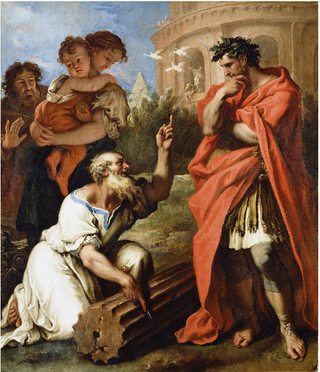
The gens Tarquinia was a plebeian family at ancient Rome, usually associated with Lucius Tarquinius Priscus and Lucius Tarquinius Superbus, the fifth and seventh Kings of Rome. Most of the Tarquinii who appear in history are connected in some way with this dynasty, but a few appear during the later Republic, and others from inscriptions, some dating as late as the fourth century AD.
The gens Afrania was a plebeian family at Rome, which is first mentioned in the second century BC. The first member of this gens to achieve prominence was Gaius Afranius Stellio, who became praetor in 185 BC.

The gens Vipsania or Vipsana was an obscure plebeian family of equestrian rank at ancient Rome. Few members of this gens appear in history, although a number are known from inscriptions. By far the most illustrious of the family was Marcus Vipsanius Agrippa, a close friend and adviser of Augustus, whom the emperor intended to make his heir. After Agrippa died, Augustus adopted his friend's sons, each of whom was considered a possible heir to the Empire, but when each of them died or proved unsuitable, Augustus chose another heir, the future emperor Tiberius.
The gens Orbia was a minor plebeian family at Rome. No members of this gens are known to have held any magistracies, but many of them are known from inscriptions. The most illustrious of the family may have been the jurist Publius Orbius, a contemporary of Cicero.
The gens Pescennia was a plebeian family at ancient Rome. Members of this gens are first mentioned in the time of Cicero, but it was not until imperial times that they came to prominence. The Pescennii were of equestrian rank. The most illustrious of the family was Gaius Pescennius Niger, an able general, who was proclaimed emperor in AD 193, only to be defeated and put to death by Septimius Severus the following year.

The gens Petillia or Petilia was a plebeian family at ancient Rome. Members of this gens first appear in history at the beginning of the second century BC, and the first to obtain the consulship was Quintus Petillius Spurinus in 176 BC.
The gens Petreia was a minor plebeian family at ancient Rome. Members of this gens are first mentioned toward the end of the second century BC, and several were distinguished as soldiers, but none of them ever attained the consulship.
The gens Pontilia was an obscure plebeian family at ancient Rome. Hardly any members of this gens appear in history, but a number of them are mentioned in inscriptions.
The gens Proculeia was a minor plebeian family at ancient Rome. Members of this gens are first mentioned at the end of the Republic. Gaius Proculeius was one of the most trusted friends and advisers of Octavian, and one of those whom he considered a possible heir. None of the Proculeii ever obtained the consulship, but a number are known from inscriptions.
The gens Remmia, occasionally written Remia, was an obscure plebeian family at ancient Rome. Only a few members of this gens are mentioned in history, of whom the most illustrious was the grammarian Quintus Remmius Palaemon, but many others are known from inscriptions.
The gens Saturia was an obscure plebeian family of equestrian rank at ancient Rome. Members of this gens are first mentioned in the time of Cicero, and a number of them had distinguished military careers, but none of them attained any of the higher offices of the Roman State.
The gens Silicia, possibly the same as Selicia, was an obscure plebeian family at ancient Rome. Hardly any members of this gens are mentioned in history, but a number are known from inscriptions, many of them from Roman Africa.
The gens Sellia or Selia was an obscure plebeian family at ancient Rome. Members of this gens are mentioned in the time of Cicero, but none of them attained any of the higher offices of the Roman state.
The gens Suettia or Suetia was an obscure plebeian family at ancient Rome. Members of this gens are mentioned in the time of Cicero, but none of them achieved any of the higher offices of the Roman state.
The gens Tannonia was an obscure plebeian family at ancient Rome. Few members of this gens are mentioned in Roman literature, but many are known from inscriptions.
The gens Tatia was a minor plebeian family at ancient Rome. This gens is perhaps best known from the legendary figure of Titus Tatius, a Sabine king who fought against Romulus, and who subsequently became joint ruler of Rome. None of the Tatii held any of the higher magistracies of the Roman Republic, but a number are known from inscriptions.
The gens Tituria was an obscure plebeian family at ancient Rome. Few members of this gens appear in history, of whom the most famous is Quintus Titurius Sabinus, one of Caesar's legates during the Gallic Wars. Other Titurii are known from inscriptions.
The gens Titurnia was an obscure plebeian family at ancient Rome. Few members of this gens are mentioned in history, but others are known from inscriptions.
The gens Turia, occasionally written Turria, was a minor plebeian family at ancient Rome. Several members of this gens are mentioned by Roman writers, although none of them ever obtained the consulship. Lucius Turius, who stood for the consulship in the late Republic, was praetor in 75 BC.
The gens Tutia was an obscure plebeian family at ancient Rome. Only a few members of this gens are mentioned by Roman writers, but a number of others are known from inscriptions.




